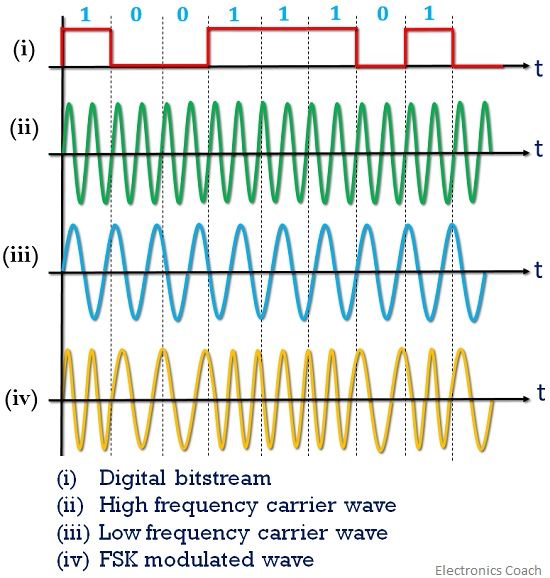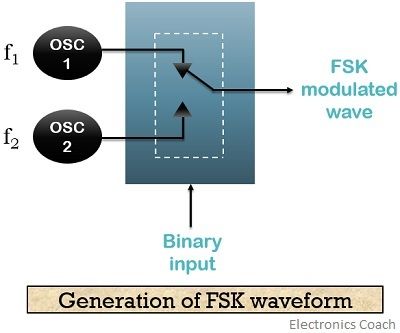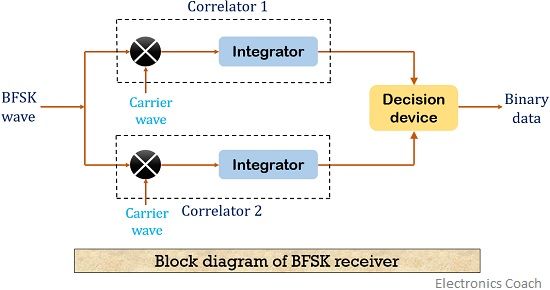Definition: A digital modulation technique that allows data transmission by changing the frequency of the carrier wave according to the digital modulating signal is known as frequency shift keying (FSK).
It is the most straightforward and efficient digital signal transmission scheme.
Theory of Frequency Shift Keying
The simplest form of FSK is Binary frequency shift keying (BFSK). Here, the frequency of the carrier wave changed between discrete binary values of the modulating signal. Thus, the frequency of the carrier shows variation according to the binary message signal.
In frequency shift keying, the carrier is modulated in such a way that high-frequency signal is achieved for high level i.e., 1 of binary data input. Similarly, the low-frequency signal is obtained in case of low level i.e., 0 of the message signal.
The figure below shows the binary frequency shift keying technique:

Here as we can see, that in the figure (i) the modulating signal in the form of the bit stream is present. Figure (ii) and (iii) shows the high and low-frequency waveform.
The (iii) figure shows the FSK modulated waveform, whose frequency shows variation according to the digital signal.
Generation of FSK
The figure below shows the generation of FSK modulated wave. Here, as we can see that the system consists of 2 oscillators that generate high and low-frequency signal separately. A binary message signal is provided to the transmitter circuitry. The carrier wave from the two oscillators and binary modulating signal operates the switch.
Here, as we can see that the system consists of 2 oscillators that generate high and low-frequency signal separately. A binary message signal is provided to the transmitter circuitry. The carrier wave from the two oscillators and binary modulating signal operates the switch.
In the case when the modulating signal bit is high i.e., 1, the switch gets closed forming a path for a high-frequency wave to get transmitted that is generated by oscillator 1.
Thus a high-frequency signal is achieved in case of bit 1 of the message signal.
As against when the input bit is level low i.e., 0, the switch now gets closed in a manner to form the path for the low-frequency carrier to get transmitted. This low-frequency carrier is generated by the oscillator 2.
Hence, it is clear that a low-frequency signal is achieved in case of a low data bit of the modulating signal.
However, in order to eliminate phase discontinuities of the signal at the output, an internal clock is provided to the oscillator. Thus, the high or low-frequency signal is selected according to the digital modulating signal.
Thus, an FSK modulated wave is transmitted and achieved at the output.
Detection of FSK
Detection technique of FSK signal is mainly categorized as coherent and non-coherent detection. As we have already discussed in the detection of ASK waveform that coherent detection needs synchronization with the transmitter section.
- Coherent detection
The figure below shows the block diagram for the coherent detection of BFSK signal.
As we can see that it consists of 2 separate mixers followed by the integrators that form the two correlators in the circuit. The output of this correlator is then fed to the decision device. This decision device generates the binary signal which is the original modulating signal.
Here, a BPSK waveform is fed to the mixer along with the two separate carriers that are accurately synchronized with the carrier waves at the transmitting end. The output generated by the mixer is then fed to the integrator.
The output of the two separate integrators is then compared by the decision-making device. When the output of integrator 1 is more than that of the integrator 2 then the frequency of the carrier associated with correlator 1 generates the bit symbol. Assume, it to be a high-frequency carrier then a logic high is generated at the output.
Similarly, when the output of the integrator 2 exceeds integrator 1 then the carrier frequency associated with correlator 2 generates symbol in favour of that frequency. Let us assume conversely that it is a low-frequency wave then symbol 0 is achieved at the output.
- Non-coherent detection
When we talk about non-coherent detection then no any synchronized carrier is required at the detector. The figure below shows the block diagram for non-coherent detection.

It consists of two separate Bandpass filter that is tuned to two different frequencies. The output of this BPF is then fed to an envelope detector which generates two separate output according to the signal achieved from the BPF.
A decision-making device then compares the output of the two envelope detector. When the output of detector 1 exceeds detector 2 then logic 1 is obtained and when the output of detector 1 is deceeded by detector 2 then logic 0 is obtained as the output.
Thus the original bitstream is generated by the detector.
The process of non-coherent detection of the FSK signal is somewhat more than the coherent detection process.
Advantages of frequency shift keying
- FSK provides better noise immunity.
- The signal transmission through FSK is quite simple.
- It is suitable for long-distance data transmission.
- Bit error rate performance is better than ASK.
Disadvantages of frequency shift keying
- It utilizes more bandwidth as compared to ASK and PSK thus is not bandwidth efficient.
- Detection of the signal at the receiver is somewhat complex.
Applications of frequency shift keying
- The technique is used in the high-frequency data transmission system.
- Extensively used in low-speed modems.
It is noteworthy in the case of frequency shift keying that only the variation in frequency is noticed, however, the phase and amplitude of the carrier do not show any variation.
Leave a Reply